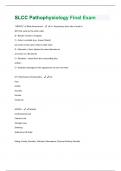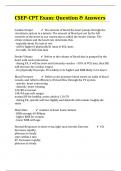Exam (elaborations)
SLCC Pathophysiology Final Exam Questions & Answers Rated 100% Correct
- Course
- Institution
"ABCDE's" of Mole Assessment - A = Asymmetry (one side of mole is NOT the same as the other side) B = Border of mole is irregular. C = Color is variable (e.g., brown/ black/ tan colors in the same mole) or dark color. D = Diameter > 6mm (about the same diameter as an eraser on a #2 pencil)...
[Show more]




